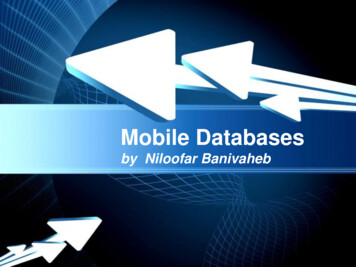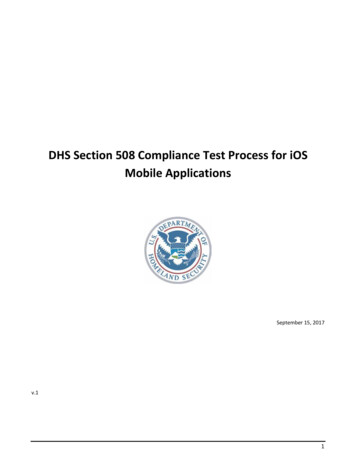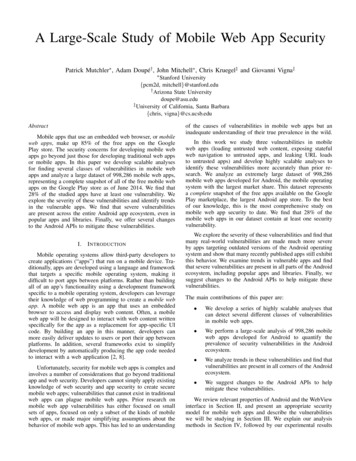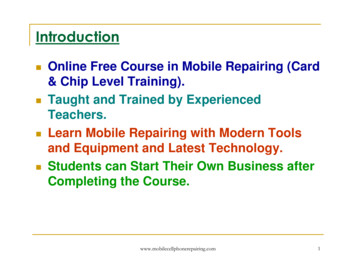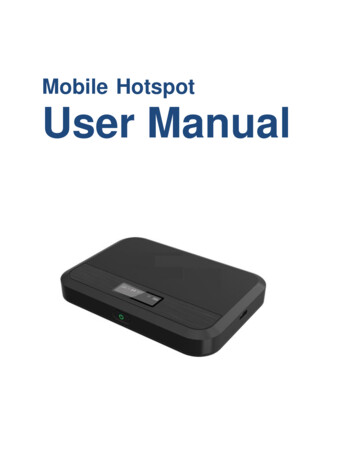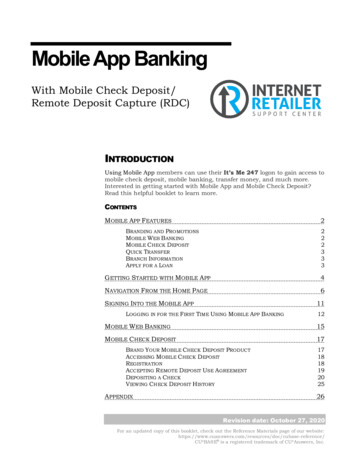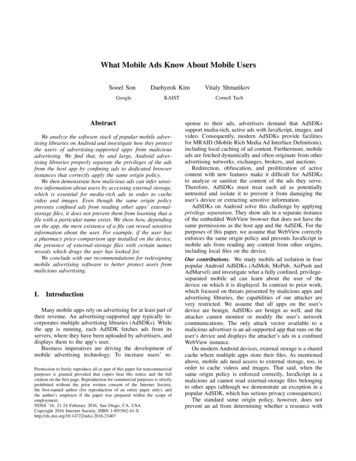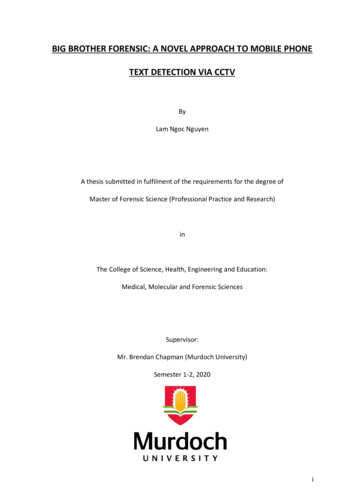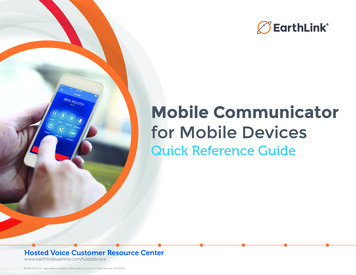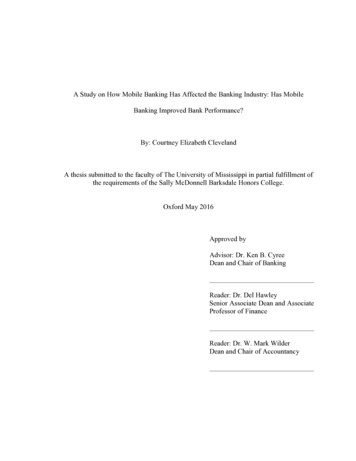
Transcription
A Study on How Mobile Banking Has Affected the Banking Industry: Has MobileBanking Improved Bank Performance?By: Courtney Elizabeth ClevelandA thesis submitted to the faculty of The University of Mississippi in partial fulfillment ofthe requirements of the Sally McDonnell Barksdale Honors College.Oxford May 2016Approved byAdvisor: Dr. Ken B. CyreeDean and Chair of BankingReader: Dr. Del HawleySenior Associate Dean and AssociateProfessor of FinanceReader: Dr. W. Mark WilderDean and Chair of Accountancy
2016Courtney Elizabeth ClevelandALL RIGHTS RESERVEDii
ABSTRACTCOURTNEY ELIZABETH CLEVELAND: A Study on How Mobile Banking HasAffected the Banking Industry: Has Mobile Banking Improved Bank Performance?(Under the direction of Ken Cyree)This paper explores the effect of mobile banking on the banking industry. Itfurther seeks to investigate if banks improve financial performance as well as customerconversion and retention due to mobile banking. The research sifts through early entriesin mobile banking features, data transfer technology evolution along with hand-heldmobile device advances. Population demographics are also reviewed to understandwhich segment is more inclined to use mobile banking applications, giving banks insightsand analytics for focused advertising. Data security needs and bank personnel skillsevaluation show a shift in personnel skill-set evolution from historical employees.Overall, the data suggests that bank performance does improve on the balance sheet andin customer conversion/retention when the bank has leading-edge mobile bankingfeatures along with disciplined cost reduction in front-line tellers and reduction in brickand-mortar investments.iii
ACKNOWLEDGEMENTI would like to thank my advisor, Dean Cyree for his guidance and input on thisthesis. His knowledge in the world of banking has been of great use and far supersedesmine. I also want to thank him for his patience in the task of writing a paper with me. Iwant to thank my second two readers, Dean Wilder and Dr. Hawley for their intriguingquestions and edits. Thank you to the Sally McDonnell Barksdale Honors College forallowing me to be a student within their body for the past four years and learn from thegreat minds surrounding me. I also want to thank them for the opportunity to travel toBoston and begin my research for this thesis. Finally I want to thank my parents forencouraging me in everything I do and for the hours they spent helping me make sense ofmy thoughts.iv
TABLE OF CONTENTSAbstract iiiAcknowledgment .ivList of Tables and Graphs viI.Introduction .1II.Literature Review .3III.History of Mobile Banking 5IV.Mobile Banking versus Mobile Payments .7V.Change in Technology .8VI.Growth in Users .13VII.Growth in Smart Phones 15VIII.Current State of Mobile Banking .17IX.Customer Concerns 20X.Profit and Revenue Growth Opportunities 24XI.Top-Performing Banks in the Nation in Mobile Banking .28XII.Performance Review Over Time of Top Banks 31XIII.Risks and Recommendations 32XIV. Opinion and Conclusion .34Bibliography .36v
LIST OF TABLES AND GRAPHS1. 25 Years of Bandwidth .92. A short history of mobile banking .103. U.S. Mobile Market Share by Platform .124. Mobile Banking Adoption Increased by 40% in 2013 145. Number of smartphone users in the United States from 2010-2019 .166. Most common mobile banking activities 187. WHERE BANKS ARE INCREASING TECH SPEND 218. Text your account. It texts you back .239. An Average FI Can Save Almost 50 Annually with each Customer that usesMobile over branch for a Single Monthly Deposit 2510. Best Institution, Best for customers who want , Room for improvement.28vi
I.IntroductionThe landscape of banking is changing. Customer expectations are evolving and banksare looking for new ways to attract and satisfy profitable customers. I hypothesize thatone way for banks to satisfy customers profitably is through mobile banking. Digitalleaders in surrounding industries are pushing the banking industry to improve their digitalperformance. I explore the evolution of mobile banking within the banking industry andhow it has affected change. In the instance of this thesis, mobile banking includes onlinewebsites, mobile apps, and SMS banking channels. The timeframe from the introductionof mobile banking and its growth thereafter to the current time or as data is available isthe evaluation period. I explore what products or services are offered, why it appeals tocustomers, and what the bank gains by offering mobile banking. I also briefly explore thekey influences or enablers on mobile banking and the impact of such. I hypothesize thatmobile banking reduces costs for the bank, thereby improving their performance.Additionally, I investigate if the new banking delivery method shift customer behaviorand becomes a required product offer just to compete.To investigate my hypothesis, I have researched studies commissioned by thebanking community regarding consumer behavior, read academic papers andpublications, conversed with banking professionals in this field and academic leadership1
about this subject matter. I have formed my own opinions from the dialogue and datathat I have tested with my research and mentor group, allowing me to arrive at my ownconclusions in which I will share through this writing. I will first discuss the applicableliterature, the history of the market and opportunities for mobile banking, the effects onthe banking industry, and finally my conclusions.2
II. Literature ReviewI have researched and read a variety of sources to bring a broad perspective to thisthesis. Opinion pieces, such as the Wall Street Journal or The Financial Brand, offerprofessional spotlights on customer thoughts regarding mobile banking and the directionin which it is headed. Studies by consulting groups like Accenture and Javelin Strategy &Research and bank surveys offer valid and timely data on the trends and past performanceof mobile banking. Academic papers provide prior research in related fields and offertheir conclusions. All references in this paper have been of great value and have stirredmy own conclusions about mobile banking and the role it plays in the industry today.The Federal Reserve conducted research about mobile banking that was helpful inunderstanding the trends occurring in this industry. They summarized rising adoptionrates and the fact that growth in mobile banking has followed the same pattern as growthin smart phone usage. The study depicts banking activities that customers use on mobileapps the most. They also highlighted the customer concern of security when choosing toadopt mobile banking.A paper by Robert DeYoung featured in the Journal of Banking and Finance findsthat Internet banking, a predecessor to mobile banking, does help community banks toimprove their profitability. He also found that there was a movement from checking3
accounts and demand deposit accounts to money market deposit accounts associated withthe growth of Internet banking.Ram Acharya noted in his paper, based on online banking applications and bankperformance, that banks with a wider mix of products and ways to access them havebetter profit efficiency. His research concluded that banks would have to continueoffering digital delivery channels to stay competitive.Bank of America recently started conducting an annual millennial snapshotsurvey to measure the impact of this tech-savvy generation on the banking industry asthey move into their prime spending years. They concluded that technology is a strongdriver in money management (Bank of America, 2015).4
III. History of Mobile BankingMobile banking was first introduced in the late 90s-early 2000s when the Internetbegan to gain popularity. A few select large banks like Wachovia and Wells Fargo startedto offer simple services on their bank websites such as viewing checking accountbalances and finding the nearest ATM, yet they did not offer interactive services. At thispoint in time, it was unclear as to what the evolution would be, but many thought that itmay be limited to personal computers with much less thought of laptops, notebooks,smart phones or even wrist watch technology that are prevalent today. Smart phoneswere far from concept then, where as they are widely used today, which has proven to bea driver of mobile banking growth. Needless to say, mobile banking in its infancy did notthrive in the early days for several reasons in addition to the above reasons.Bank websites were accessed through non-user-friendly web browsers and weredifficult to use. Poor functionality, slow screen refresh speed and a limited quantity offeatures contributed to why customers did not readily adopt banking channels beyondphysical branches and ATMs. Costly web hosting and website design services and theinability to revise or refresh the functionality made it difficult, or more importantly risky,for the banking industry to move key service offerings to the web-based channel.Security in banking was and is always a fundamental concern. This foundational element5
was thought to be a key challenge to offering services beyond just read-only, noninteractive offerings.Profitability and investor performance were key aspects to evaluate by bothcommercial banks and investment banks when investing in mobile banking technology.It was unclear in the early days how current or concept mobile services would interactwith the existing offerings, and the employee base, as well as support the bank brandsthat had been built on personal customer service.6
IV. Mobile Banking versus Mobile PaymentsMobile payment services preceded mobile banking and were widely accepted bymerchants and consumers alike. Mobile payments are either person-to-person paymentsfrom a phone or person-to-merchant point of sale payments from a phone. An early formof use saw dial-up technology used from merchant facilities to banks or bank clearinghouses to make immediate credit card transactions. The dial-up technology was slow andlimited to few simultaneous users. Often multiple attempts were needed to complete thetransaction, which could frustrate both merchants and consumers. Over time theevolution of Internet services and telephone company technology, including thedeployment of fiber-optic cables and wireless technology, started a more robustexpansion of this early use.Mobile banking is using a cellular phone or smart phone to access bank accountsand perform accounting features. It also includes accessing other features of bankwebsites such as loan applications and interactive investment banking data to mention afew. Over the course of a couple years, the two streams of use converged through oneapplication (app), and by using the same encompassing technology, sharply expanded thecombine feature use. (Canright, 2012).7
V. Change in TechnologyThe evolution of several technologies thrust mobile banking into mainstream use.The rapid changes in telephone transmission, from copper wires to fiber-optic cables towireless broadband and its expanded bandwidth, have allowed platforms to expand and insome cases re-launch mobile banking. It is not the intent to develop the details of thistelephone evolution in this writing, yet it is important to note the impact of this evolutionon mobile banking. If not for these new technologies, mobile banking may havefloundered with limited features and mediocre reception. Data can be viewed in Table 1.8
Source: Innova Global Technology Inc. (2016) [The graph shows a representation ofbandwidth growth over the past 25 years.] 25 Years of Bandwidth. Retrieved ructure-installationWith the advancement of wire and wireless technologies, banks had to adapt aswell. When they first rolled out mobile banking, they used technology called WAP, orwireless application protocol, browsers. These are standard formats for digital programs.Some banks started making their own apps from the start, which is now the morecommon trend. Some banks offered different apps for different features. For example,account balance checking, finding nearby ATMs/branches, or transferring funds could bedone in one app and more sophisticated services like personal financial management9
(PFM) could be done from a second app. Eventually, the services merged into one userfriendly app to save customers from “mobile fatigue.” It is also important to note anotherindustry advancement and that is the evolution of personal computing programs in thewindows technology and onward to the mobile device application (app) development(Johnson, 2011).This is reflected in Table 2, the mobile banking overview by ida Mobile in theJune 14, 2012 presentation given by Lorenzo Bolognini.10
Source: iDa Mobile. [The visual conveys the four main types of technology behindmobile banking.] A short history of mobile banking. Retrieved ey-13321960Table 3 reflects the sharp growth in app development that has been adopted byconsumers. Regardless of the type of mobile technology (i.e., android, Apple, etc.),consumer demand for applications or app use was seeing an exponential growth. Thefunctionality of these apps was becoming more user-friendly while the depths of serviceswere expanded across all industries. Specific to banking, these apps were bringing thefull array of brick-and-mortar banking onto a mobile device. Web and applicationdesigners were launching technology that was being acquired, utilized, and marketed bylarge and small institutions including the banking community. The point to be made fromthis chart is that banking institutions were enjoying the benefits of the explosion of appdevelopment by independent and corporate developers alike. It gave the banks anopportunity to select from the many options that would fit their brand and product profile.11
U.S. Mobile Market Share by PlatformSource: ComScore (2014). [The graph shows the growth of several different mobileplatforms and their market share.] U.S. Mobile Market Share by Platform.[PowerPoint slides] Retrieved from Paul Wiggins of Jack Henry andAssociatesI submit that the growth in data transmission technology, mobile devices and appdevelopment were instrumental in the growth of mobile banking.12
VI. Growth in UsersAs the technologies improved in data transmission and app development, mobilebanking made a second entrance around 2009 and has seen steady increases each year inbanking institutions offering mobile services. In 2014, 78% of financial institutionsoffered mobile banking (Board of Governors of the Federal Reserve, 2015). The questionthat many banks had to answer in this season of re-launch was to what degree they wouldoffer services? Would the mobile service offering be the cost of entry or could it becomea competitive advantage? It became evident very quickly that banks had to offer moreadvanced services just to compete for the business of consumers. The industry evenbegan to see online/mobile-only banks enter the market, validating the need to havemobile services even if you were a brick-and-mortar emphasized organization.As it relates to user adoption, the Javelin Strategy & Research Group reports astrong growth curve beginning in 2011 and a sharp increase in 2013. Their projectionssuggest a fairly linear growth year-on-year through 2018. It also suggests that if youextrapolate the data from 2013 to 2018, the number of adult users will be approaching150 million. Refer to Table 4.13
Source: Javelin Strategy and Research (2014). [The bar graph depicts the growth inmobile banking adoption by adults in the U.S. from 2011 to 2019.] MobileBanking Adoption Increased 40% in 2013. Retrieved fromhttps://www.google.com/url?sa t&rct j&q &esrc s&source web&cd 8&ved 0ahUKEwjAoL78qczMAhWHMyYKHYGGBKEQFghJMAc&url 21%2Fdownload%3Ftoken%3DpkjQISMH&usg AFQjCNFVRxFxEZISbHNbpBBzDFPWFuX7tw&bvm bv.121421273,d.eWE14
VII. Growth in Smart PhonesAs the data transmission industry evolved, mobile technology followed suit bytaking advantage of this newfound bandwidth. The introductions of the iPhone and othersmart phones with similar platforms have been a steady factor in the growth of mobilebanking. Smart phones have digitized many everyday tasks for Americans. Theefficiency it brings to everyday tasks allows many Americans to regain valuable timespent in commuting and engaging in brick-and-mortar banking.Some age groups adapt quicker to a digital experience, like Gen. X and Y, ormillennials. These groups are an integral part of growing mobile banking because theyare poised to become core-banking customers in the near future. They also make up thelargest generation in the U.S. population. Individuals that fall within these generationlines will begin to become employed, look for loans, buy homes, start families, etc. Theyare not quite at that stage yet because of factors like student debt and a poor job market,but their affinity for anything digital will be of great importance when choosing how theywant to bank. Their use of banks will become a determining factor in bank performance.The U.S. Chamber of Commerce estimates the millennials’ economic impact tobe 200 billion of direct purchasing power and 500 billion of indirect spending. Their15
research also found that “Millennials are 2.5 times more likely to be early adopters oftechnology than are older generations” (U.S. Chamber of Commerce Foundation, 2016).A study from Javelin Strategy & Research, quoted by Maria Aspan, states thatmobile banking customers “’tend to be younger and richer than the typical consumer’”and “45% have at least 50,000 in investible assets with their banks” (Aspan, 2013). Ontop of that, 43% of mobile banking customers have an annual salary of at least 75,000.With this target clientele, the banks must continue to offer more features to bring newcustomers into their brand and hold or advance their market share. Table 5 below showsalmost the same growth curve that mobile banking customers’ adoption reflects.Source: Statista (2016). [The bar graph shows the growth in adult smartphone users in theUnited States.] Number of smartphone users in the United States from 2010 to2019. Retrieved from -ofsmartphone-users-in-the-us/16
VIII. Current State of Mobile BankingA study by five of the Federal Reserve Banks states that 78% of banks alreadyoffer mobile banking, 16% plan to offer it within the next year, and 4% do no plan tooffer it all. The data suggests that having mobile banking as a primary channel offeringis really part of the price of entry into the commercial banking world. Having andevolving mobile banking features will be required to maintain relevance (Board ofGovernors of the Federal Reserve, 2015).The research from the Federal Reserve is reflected in Table 6, which summarizesthe usage of key mobile banking activities.17
Source: Marous, J. (2015, August 10). Mobile Banking Usage to Double. RetrievedMarch 08, 2016, from nking-usage-study/Banking executives and their analytical talent pool have to deploy unconventionalskills in tracking technology changes to ensure their bottom line is sound. Once upon atime, the balance sheet, 10K and annual report really focused on the risk of the portfolio.Employing finance and accounting-based workforce was adequate to ensure theshareholders’ investments were safe and performing. Today, banks are employing peopleand consultants to track speed of change and evolution of technologies that couldincrease the pace of channel evolution or even open new channels. Additionally, this18
requires that the speed of decisions of the banking industry must have to evolve to keeppace with the tech industry (American Banker, 2015).19
IX. Customer ConcernsIn every study performed, whether by banks, consulting agencies, newspaper orwhoever else, concerns about security is the number one reason listed across the boardfor why individuals are resistant to adopting mobile banking. Having armed guards at thedoor and a Brinks truck were once the key security steps required to maintain the securityof the customer investments, but with mobile banking, this is no longer the only customerconcern.With the evolution of mobile banking, the security requirements have alsorequired advancement. Banks quickly reached out to high-tech firms to hire their toptalent or secure consulting contracts to support software required to manage mobilebanking.Today, most companies have a seat on the board entitled Chief Security Officer.They have a staff of conventionally and unconventionally educated employees who lookafter the security of the electronic banking activities. Conventionally educated typicallymeans educated at colleges and universities who have developed curricula to trainstudents in this area. Unconventional training could come from former hackers and selfmade talent who can think like a criminal such that technology gaps can be closed beforethe public discovers them. Again, this area of the organization was non-existent 20 years ago, reflecting the need to evolve to survive. Refer to Table 7.20
21
Source: American Banker (2015). [The table shows what technology banks are spendingmoney on in decreasing order of percentage of money.] Where Banks areIncreasing Tech Spend. Retrieved -security-1077200-1.htmlThe second most commonly listed reason for resistance to adopting mobilebanking is customers not being aware of the services that are offered. Marketing formobile banking was initially done mainly through in-branch advertising and banneradvertising on bank websites. The paradox of these efforts is that the channels used toadvertise mobile banking are the very channels that the banks are looking to transitioncustomers away from in order to grow the mobile channel. Studies show that other formsof marketing would be more effective.One alternative is social media. Social media is already a mobile phenomenon,and many users of social media are readily open to adopting mobile banking to satisfytheir banking needs. Another method is through cookie tracing. Most mobile devicesleave the cookie tracing option open to track website use. The marketers can targetmarket to the users who have propensity to click through select websites. Thismethodology is very effective in one-to-one marketing and where messages can betailored to the potential target.Table 8 shows an example of Chase.com target email click to website.22
Source: Finovate (2008). [The chart depicts a Chase Bank advertisement for theirtext-banking feature.] Text your account. It texts you back. Retrieved /23
X. Profit and Revenue Growth OpportunitiesAnytime banks introduce new payment channels or services, there is theopportunity to profit. As this new technology use became widely popular, it also becamea price of entry to compete. Most banks made mobile banking a free offering and focusedon front-line and back-office workforce reduction to save money. This was and is asignificant tactic to offer this channel just to compete. Therefore, it requires a major shiftfor bank executives to not seek revenue for a major part of their product offerings. Thosewho find ways to do this most efficiently can win the battle of lowest cost provider, thusmaintaining stronger margins than less efficient competitors. The main way noted toincrease profit is realizing reduced costs affected by mobile banking. Twenty-ninepercent of banks listed cost reduction as a reason to offer mobile banking as found by astudy done by The Federal Reserve Banks of Atlanta, Boston, Dallas, Minneapolis, andRichmond (Board of Governors of the Federal Reserve System, 2015).Table 9 is a simple example from Javelin Strategy & Research regarding inbranch and online deposits from their 4Q15 study.24
Source: Monahan, Mary. (2013, July 2). Leveraging an Omnichannel Approach toDrive 1.5B in Mobile Banking Cost Savings. Retrieved April 20, 2016 nking-cost-savingsBy converting deposit services to a mobile channel, banks are able to realize thesavings of less in-branch deposits. The research by Javelin estimates 1.5 billion in costsavings for the banking industry. “Since 2010, branch visits have dropped dramaticallyby 10 percentage points, while mobile banking has risen by the same amount” (Monahan,2013). In an article from the American Banker in 2013, Citigroup stated they wereclosing 44 branches as part of a cost savings plan. PNC told investors they would be able25
to lay off 40-45 tellers because they were handling over 7,000 mobile transactions daily.Banks are seeing more and more customers utilize mobile banking over branch visits.A Wells Fargo employee stated that mobile banking helps strengthen the banks’relationships with customers. The more the bank satisfies the customer with simplerservices, the easier it is to initiate conversations about more profitable financial products.Bank of America also tied their year-over-year growth in mobile banking, 31% in 2013,to their branch closures (Aspan, 2013).Research conducted by Ram Acharya, Albert Kagan, and Srinivasa Rao Lingamproved that by offering an additional online banking channel, community bankssignificantly improved their performance (Ram, 2008). Research by Robert DeYoungfound similar results. DeYoung studied small commercial banks that offer online bankingand their financial performance as a result. He concluded that by offering online banking,banks had increased profitability. “These earnings increases are primarily driven byincreases in noninterest income from service charges on deposit accounts. This impliesthat the added convenience of transactional Internet banking led some bank depositors topurchase additional fee-based services and/or to willingly pay extra for the services theypreviously purchased at bank branches” (DeYoung, 2007). A paper published in 2012studied the relationship between self-service technology investments, specifically ATMs,and financial performance of firms. The conclusion was that SSTs do improve financialperformance (Hung, 2012).I believe the research by the above-mentioned papers fully supports thehypothesis that mobile banking could improve bank performance. ATMs and then onlinebanking both preceded mobile banking in the same line of technological advancements26
and services offered. In Hung’s conclusion, he states that, “In addition to ATMs, severalkinds of self-service technologies, such as telephone banking, internet banking andmobile banking, have been utilized to deliver their services by the banking industry. Theimpacts of these alternative SSTs and their interacting effects remain unknown anddeserve further examination” (Hung, 2012). The methods of research used by thesescholars would be an excellent platform to effectively measure improved performance asa result of mobile banking.27
XI. Top-Performing Banks in the Nation in Mobile BankingIn 2009, the Tampa Tribune wrote an article about research that graded banks onhow well they were doing with mobile banking. They spoke to banks in the Tampa areaand nationally. Banks that were graded as exceptional and very good happen to benational banks such as BB&T, Wells Fargo (a first mover), USAA, Bank of America, andChase to list a few in the first two categories. Banks graded ‘below average’ includeRegions and SunTrust.In her June 30, 2015 article, Virginia C. McGuire of NerdWallet compiled amatrix of the best mobile banking institutions and some of their mobile banking featuresand benefits as well as improvement areas. Table 10 reflects a significant change from2009 to 2015 in adopters and features offered.BestInstitutionBank ofAmericaBest forcustomerswho want The ability tomakeappointmentsat a branchvia an awardwinningmobile appRoom forimprovementSpendingtracker28
BB&TCapital One360ChaseCitibankPNCSunTrustA good textbankingservice, inEnglish orSpanishA fullyfunctionalperson-topersonpaymentsystemA wellThe person-toroundedpersononline bankpaymentwith a strongfeature wasall-aroundhard to usemobile appand has beentemporarilysuspendedA good central Budgetplace totracking,manage their smartwatchChase bankappand creditcard accountsSmartwatchIncreasedcompatibility, speed,plus theimprovementsoption to see to smartwatchaccountappbalanceswithoutlogging inthrough theCiti Mobilesnapshot toolSophisticated Wealthbudgeting and managementwealthtool formanagement customerstoolswithout highbalancesTo get a quick Improvedglimpse oftransactionbalanceshistory displaywithoutsigning on29
U.S. BankWells FargoPhoto bill pay,which lets youpay a paperbillelectronicallyby snapping apictureAccess toWells Fargobankaccounts,credit card,mortgages,and rewardaccountsA free mobiledeposit serviceSmartwatchapp(McGuire, 2015)30
XII. Performance Review over Time Period of Top BanksFrom 2007-2010, Wells Fargo saw a significant reduction in deposit servicecharges and net servicing fees. Deposit service charges dropped from 11,298 in 2007 to 2,904 in 2010. Net servicing fees decreased from 89 to 10. Regions Bank haddecreasing numbers for deposit service charg
I explore the evolution of mobile banking within the banking industry and how it has affected change. In the instance of this thesis, mobile banking includes online websites, mobile apps, and SMS banking channels. The timeframe from the introduction of mobile banking and its growth thereafter to the current time or as data is available is


